For comfortable headsets, you’ll want the center of gravity positioned as close to your head’s natural balance point as possible—typically just above and behind your ears. This prevents forward-pulling that causes neck strain and pressure points. Strategic placement of heavy components like batteries and lenses, combined with lightweight materials such as reinforced plastics, creates ideal weight distribution. Adjustable headbands and ergonomic designs help redistribute weight across your head, while customizable clamping force guarantees personalized comfort for extended gaming sessions.
Understanding Weight Distribution Fundamentals in VR Design
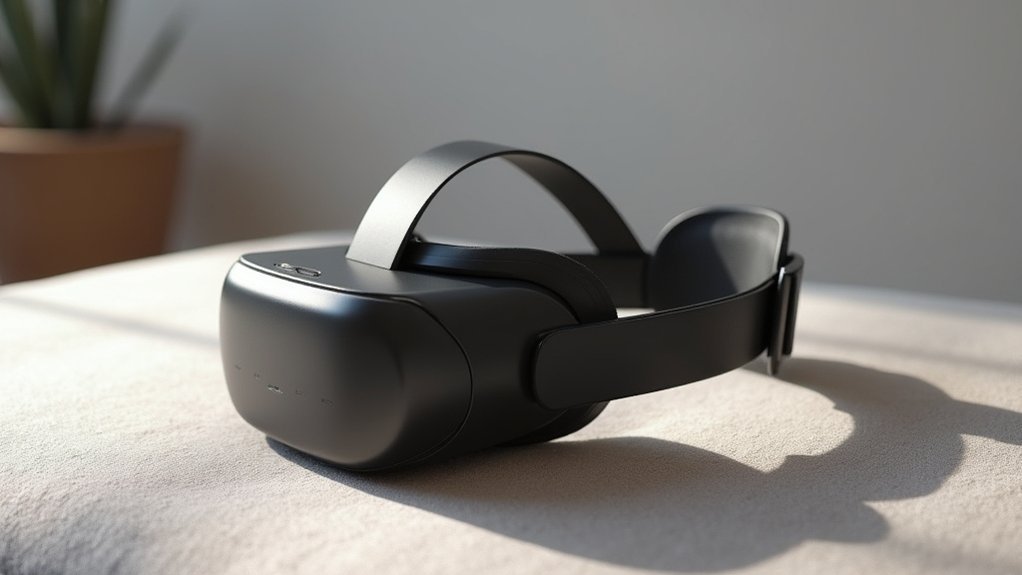
When you’re designing a VR headset, weight distribution becomes the make-or-break factor between an immersive experience and an uncomfortable ordeal.
You need to understand that comfortable headset design fundamentals revolve around strategic placement of heavier components like batteries and lenses. By centering these elements or spreading them evenly, you’ll create an ergonomic design that eliminates pressure points during extended use.
Your goal is positioning the center of gravity close to the user’s head, which dramatically improves stability and overall comfort.
When you incorporate lightweight materials such as reinforced plastics, you’re maintaining structural integrity while reducing total weight.
This approach to weight distribution guarantees your users can enjoy longer sessions without fatigue, transforming headset comfort from an afterthought into a competitive advantage that defines superior design fundamentals.
Impact of Front-Heavy Design on User Experience
Although manufacturers endeavor for balanced designs, front-heavy headsets create a cascade of comfort issues that’ll derail your VR experience before it begins.
Poor weight distribution forces excessive strain on your neck and head, generating fatigue and pressure points around your ears. You’ll notice the headset pulling away from your head, compromising sound isolation and diminishing audio quality as ear cups lose proper contact.
Front-heavy headsets strain your neck and create pressure points, causing the ear cups to lose contact and compromise audio quality.
This discomfort inevitably shortens your listening sessions, reducing overall enjoyment of gaming or music experiences. Your user experience suffers when front-heavy design creates an unstable, uncomfortable fit.
Smart manufacturers counter these problems by incorporating adjustable headbands and ergonomic shapes that redistribute weight more evenly.
These features transform potentially uncomfortable headsets into truly comfortable headsets that support extended use without causing strain or fatigue.
Balancing Battery Placement and Component Layout
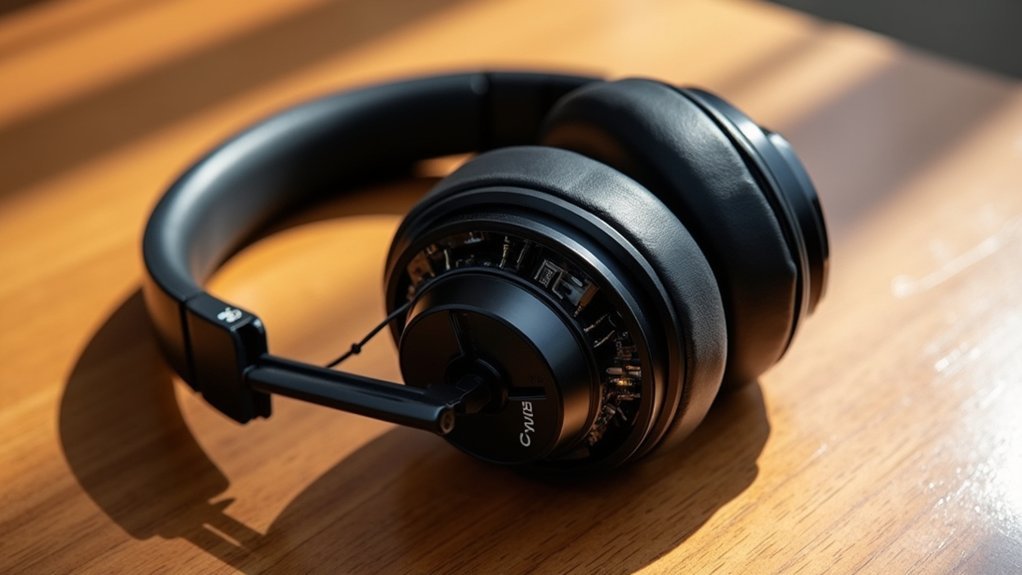
You can achieve ideal headset comfort by positioning your battery closer to your head rather than at the extremities, which reduces the leverage effect that creates top-heaviness.
Your component layout strategy should distribute weight evenly across the headset’s frame, with heavier elements like drivers and batteries balanced against lighter components such as microphones and padding.
When you strategically place these components, you’ll create a stable center of gravity that prevents fatigue during extended gaming sessions.
Strategic Battery Positioning
Since the battery represents one of the heaviest components in a gaming headset, its placement directly determines whether you’ll experience neck strain or comfortable extended sessions.
Strategic positioning near the headband creates ideal weight distribution, preventing your headset from becoming top-heavy and causing discomfort.
You’ll achieve the best comfort when manufacturers integrate lightweight lithium-polymer batteries close to your head’s center of gravity. This balanced headset design works alongside thoughtful component layout, ensuring drivers and microphones complement rather than compete with battery placement.
Proper battery integration eliminates pressure points that develop during extended use. When you’re gaming for hours, strategic positioning becomes vital for discomfort prevention.
The right headband design distributes weight evenly across your head, transforming what could be a burdensome device into comfortable, long-lasting gaming equipment.
Component Weight Distribution
When manufacturers distribute component weight effectively across your headset, they create a balanced foundation that prevents fatigue and enhances your gaming experience.
Strategic placement of internal components guarantees comfortable headphones that won’t strain your neck during extended use. Heavy audio drivers should be positioned to avoid creating pressure points, while lightweight materials in the headband and ear cups maintain headset balance without sacrificing durability.
Proper weight distribution does more than improve comfort—it directly impacts audio performance and noise isolation.
When components are arranged efficiently, the ergonomic design creates a better seal around your ears, enhancing sound quality. You’ll notice how well-balanced headsets feel almost weightless, even during marathon gaming sessions, because the load is evenly distributed across contact points rather than concentrated in problematic areas.
Ergonomic Strap Systems for Optimal Weight Distribution
While headset weight matters greatly for comfort, how that weight gets distributed across your head determines whether you’ll enjoy extended gaming sessions or suffer from pressure points and fatigue.
Ergonomic strap systems solve this challenge by spreading weight evenly across your entire head rather than concentrating it in specific areas.
You’ll want adjustable headbands that accommodate your unique head shape and size for ideal weight distribution. Look for padded headbands made from breathable materials – they’ll prevent heat buildup while cushioning contact points.
Advanced suspension systems create a “floating” sensation that noticeably reduces strain by minimizing the weight you actually feel.
Research confirms that well-engineered ergonomic strap systems greatly improve user comfort, enabling longer, more immersive gaming sessions without the fatigue that poorly designed headsets cause.
Material Selection and Its Effect on Overall Balance
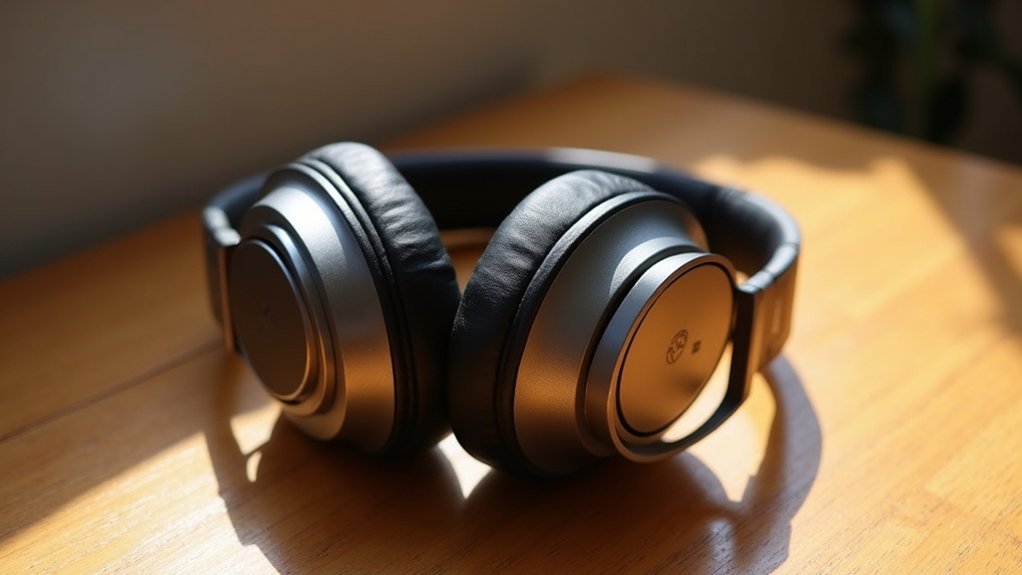
When you’re choosing headset materials, you’ll immediately notice how plastic construction keeps weight down compared to metal alternatives, directly impacting your comfort during long gaming or work sessions.
Your padding material selection creates a double effect—thicker, plush materials add weight but reduce pressure points, while lighter foams might compromise comfort for extended wear.
You’ll face constant trade-offs when manufacturers integrate features like wireless components or RGB lighting, as these additions increase weight and require strategic material choices to maintain ideal balance.
Plastic Versus Metal Construction
Although many gamers focus primarily on audio quality and features, the construction material of your headset plays an essential role in determining comfort during those marathon gaming sessions.
When choosing between plastic and metal headphones, you’ll notice significant weight differences that directly impact your gaming experience. Plastic materials typically weigh around 200 grams, while metal constructions often exceed 300 grams, creating noticeable strain during extended use.
You don’t have to sacrifice durability for comfort, though. Reinforced plastics offer excellent balance between lightweight design and structural integrity.
While metal components in headbands enhance longevity, they require careful ergonomic consideration to maintain proper weight distribution. High-grade plastic materials provide the best solution, delivering durable construction without compromising the comfort you need for peak gaming performance.
Padding Material Weight Impact
Beyond the headset’s frame construction, the padding materials you choose dramatically influence both comfort and overall weight distribution. Your headset’s performance depends heavily on finding the right balance between cushioning and lightweight design.
Memory foam offers excellent comfort without adding unnecessary overall weight, while breathable fabrics enhance airflow during extended gaming sessions. However, you’ll face trade-offs when selecting padding material options:
- Lightweight materials like memory foam provide comfort without bulk, preventing discomfort during long use
- Thicker padding offers superior cushioning but increases weight, potentially causing neck strain
- Breathable fabrics maintain comfort while contributing to better weight distribution across your head
Manufacturers prioritize lightweight yet durable materials to guarantee your headset remains comfortable without sacrificing performance, making material selection vital for ideal balance.
Feature Integration Trade-offs
Since every additional feature requires specific materials and components, you’ll constantly navigate trade-offs between functionality and weight distribution when selecting your gaming headset.
Built-in microphones add convenience but introduce extra weight that affects comfort levels during extended sessions. Wireless technology eliminates cable constraints yet requires heavier battery components and internal circuitry. RGB lighting enhances aesthetics but incorporates additional hardware that compromises overall balance.
You’ll find manufacturers face challenging design decisions between durability and comfort. While sturdier materials improve performance and longevity, they markedly increase headset weight.
Premium features like noise cancellation demand sophisticated components that alter weight distribution patterns.
Your ideal headset balances essential features with comfortable weight limits. Consider which trade-offs matter most for your gaming needs, prioritizing features that enhance your experience without sacrificing long-term comfort.
Counterweight Solutions and Their Effectiveness
When you’re dealing with a headset that feels front-heavy or creates uncomfortable pressure points, counterweight solutions offer a practical way to restore balance and improve your overall comfort.
These systems work by adding weight to the opposite side, helping redistribute mass and reduce pressure on your head during extended use.
Effective counterweight designs enhance comfort by minimizing strain from headsets weighing 200-500 grams.
You’ll find these solutions particularly beneficial:
- Adjustable systems let you customize fit for your unique head shape and size
- Built-in counterweights from manufacturers optimize weight distribution for headset stability
- User feedback consistently shows improved experiences during long gaming sessions
Adjustable Mechanisms for Personalized Comfort
While counterweights help restore balance, adjustable mechanisms let you fine-tune your headset’s fit for true personalized comfort.
Adjustable headbands accommodate different head shapes and sizes, letting you customize the fit for enhanced comfort during marathon gaming sessions. Ergonomic designs featuring swivel ear cups improve pressure distribution and create better seals around your ears.
Customizable headbands and swivel ear cups ensure optimal fit and pressure distribution for extended gaming comfort.
You’ll find adjustable clamping force particularly valuable, as it controls how tightly your headset grips your head.
Memory foam padding in ear cups and headbands adapts to your unique shape, providing a secure and comfortable fit without excessive weight. Personalization options like interchangeable ear pads give you additional ways to tailor their headsets.
These mechanisms work together to deliver the perfect balance between stability and comfort for your specific needs.
Long-Term Usage Considerations and Fatigue Prevention
Extended gaming sessions reveal the true test of your headset’s comfort design, as even the most perfectly adjusted device can cause fatigue when worn for hours.
Proper weight distribution becomes critical for maintaining your comfort level during these marathon sessions. Even headsets with adjustable features and lightweight build can cause discomfort during extended use without proper fatigue prevention strategies.
Your personal comfort depends on managing pressure on the ears and maintaining ideal fit throughout long listening sessions.
Consider these essential practices:
- Take regular breaks every 60-90 minutes to relieve pressure and allow your ears to breathe
- Adjust positioning periodically to redistribute weight and prevent pressure points
- Monitor heat buildup around ear cups and headband contact areas
These strategies help maintain comfort regardless of your headset’s design.
Frequently Asked Questions
What Is the Ideal Weight for Headphone?
You’ll find headphones weighing 200-500 grams work best, but you should prioritize comfort over exact weight. Test different models since your head shape and personal sensitivity determine what feels right for extended listening sessions.
How to Make a Headset More Comfortable?
You’ll improve headset comfort by choosing lightweight materials, adjusting the headband for proper fit, using soft breathable padding, taking regular breaks, and adding cushion accessories for extra support.
How to Stop Headphones From Hurting Ears?
You’ll reduce ear pain by adjusting your headband properly, choosing softer ear pads, taking hourly breaks, and experimenting with over-ear versus on-ear styles to find what fits your ears best.
How Heavy Should a Headset Be?
You’ll want your headset weighing between 200-300 grams for ideal comfort. Anything heavier than 300 grams can strain your neck during long gaming sessions, while lighter options reduce fatigue and maintain good sound quality.

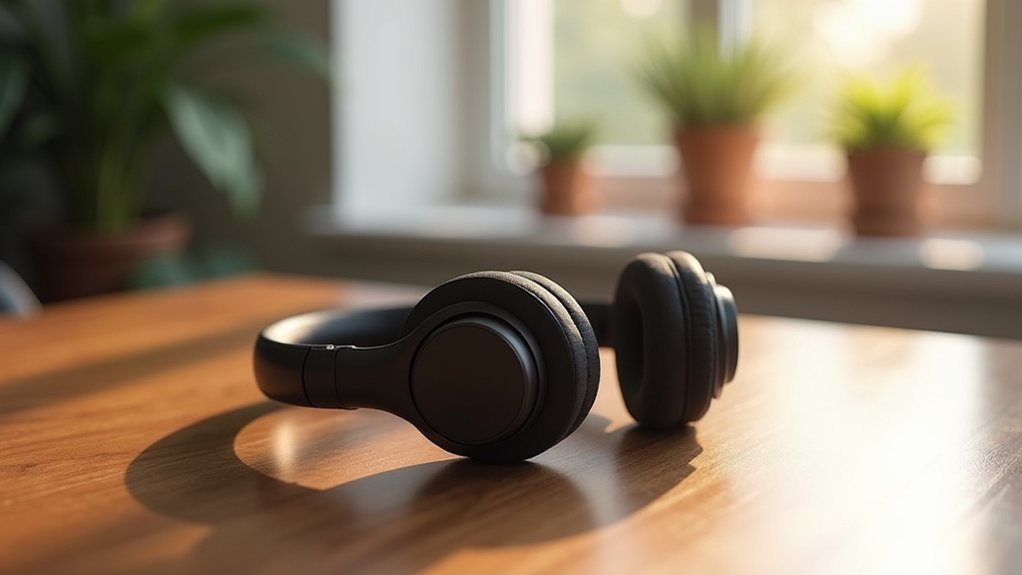

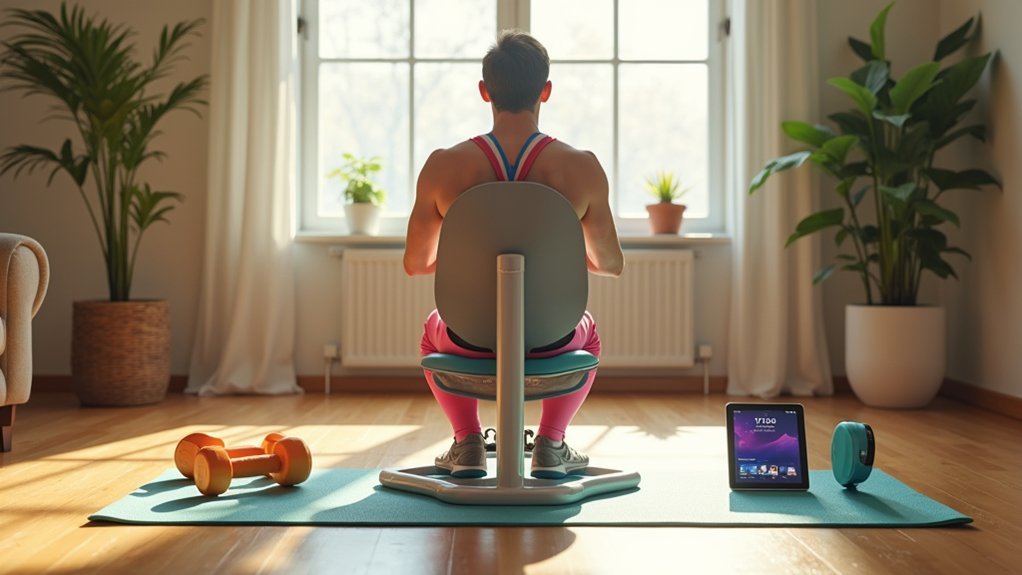

Leave a Reply